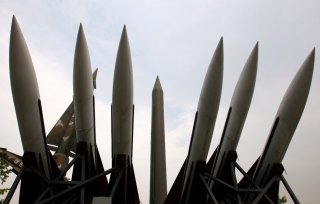Can America Fight and Win a Limited Nuclear War?
Given that Russia and the United States operate lower-yield tactical weapons, some have raised the question as to whether these kinds of weapons could “lower the threshold” to nuclear war.
Here’s What You Need to Remember: Countries deploy massively destructive weapons for the specific purpose of never using them
A newly released Navy war strategy does not rule out the possibility that Russia may envision some kind of scenario wherein they could use nuclear weapons in some kind of limited fashion to achieve a combat effect while precluding retaliation.
“In conflict, Russia may threaten cyber or kinetic strikes against Washington or European capitals, or attack undersea communications cables, causing severe impact to the global economy. It may also gamble that use of nuclear weapons might avert defeat in combat or preclude retaliation,” the Navy, Coast Guard, and Marine Corps strategy, “Advantage at Sea: Prevailing With Integrated All Domain Naval Power,” states.
Upon what kind of strategic basis might Russia think it could “preclude retaliation,” something which would undermine, overturn or just simply contradict the basic premises of the U.S. Strategic Nuclear Deterrence concept intended to prevent first use. The thinking might be that some kind of initial targeted, yet crippling first strike tactical nuclear attack could enable rapid take over a disputed area, all while raising the risk level so high that the U.S. simply might choose not to respond to avoid global catastrophe. If something close to this represents any kind of Russian thinking on the question, it would be an extremely risky approach to take. After all, the entire premise of U.S. nuclear deterrence strategy is to ensure complete destruction with retaliatory strikes should any kind of a first-use of nuclear weapons happen. Nuclear-armed ballistic missile submarines, bombers on patrol in the region, fighter jets, or carrier strike groups operating within striking distance would all be key elements of any U.S. strategic interest in preventing any kind of first strike to happen.
However, given that Russia and the United States operate lower-yield tactical weapons, some have raised the question as to whether these kinds of weapons could “lower the threshold” to nuclear war and leave potential adversaries to think some kind of nuclear weapons might be a realistic option? This is why many advocates for a strong deterrence posture are clear to suggest that a clear message be sent that any use of nuclear weapons, on any scale, will ensure a significant and highly lethal counterattack.
Instead of lowering the threshold and making some kind of nuclear warfare exchange more possible, many prominent U.S. military leaders are clear that the Pentagon’s ongoing efforts to engineer and deploy low-yield tactical nuclear weapons can actually strengthen deterrence by ensuring an immediate response to any kind of Russian nuclear weapons use. Some of these new tactical, low-yield nuclear weapons are already here, such as the new Submarine Launched Ballistic Missile, an adapted variant of the Trident II D5 missile, the nuclear-armed, air-launched cruise missile called the Long-Range Stand-Off weapon, and various kinds of air-dropped nuclear bombs.
The entire idea is based upon a contradiction or paradox … deploy massively destructive weapons for the specific purpose of never using them.
Kris Osborn is the defense editor for the National Interest. Osborn previously served at the Pentagon as a Highly Qualified Expert with the Office of the Assistant Secretary of the Army—Acquisition, Logistics & Technology. Osborn has also worked as an anchor and on-air military specialist at national TV networks. He has appeared as a guest military expert on Fox News, MSNBC, The Military Channel, and The History Channel. He also has a Master's Degree in Comparative Literature from Columbia University.
Image: Reuters

